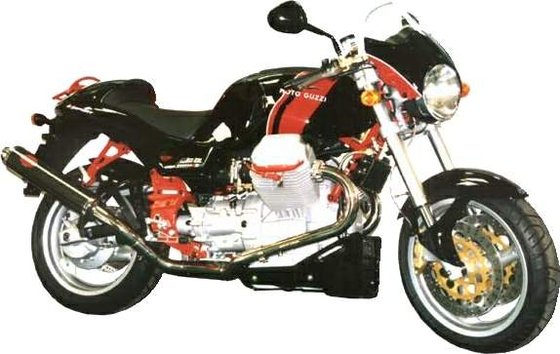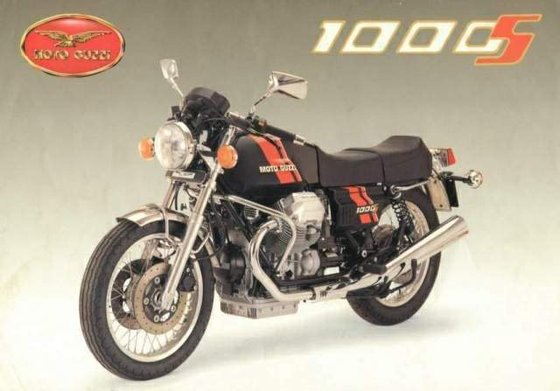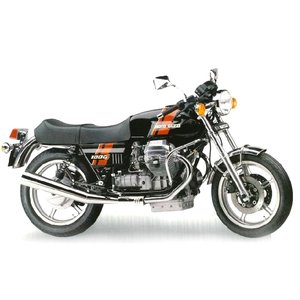Moto Guzzi 1000 S [1989-1993]: A Timeless Italian Icon Revisited

Introduction
The Moto Guzzi 1000 S, produced between 1989 and 1993, is a motorcycle that defies era-based categorization. With its nostalgic design cues from the 1970s and a robust 949cc V-twin heart, this Italian machine straddles the line between classic charm and surprisingly modern usability. After spending time with a meticulously maintained 1991 example, it’s clear why this model remains a cult favorite among enthusiasts who crave mechanical character and head-turning style. Let’s explore what makes the 1000 S a compelling proposition even decades after its discontinuation.
Design & Styling: Retro Done Right

The 1000 S is a deliberate homage to Guzzi’s 1970s sport heritage, specifically the 750 S3. Its design language screams “classic” with hand-painted diagonal stripes (orange or green), chrome accents on the exhausts and fenders, and a teardrop-shaped fuel tank that could’ve been lifted straight from a café racer catalog. The spoke wheels—our test bike’s optional cast alloys added a slightly more modern flair—and low-slung handlebars complete the vintage aesthetic.
Yet, there’s a subtle modernity here. The polished stainless-steel instrument panel (introduced in later models) houses a clear speedometer, tachometer, and warning lights, avoiding the fussiness of purely retro gauges. At 780 mm (30.7 inches), the seat height is accessible, though the bike’s 215 kg (474 lbs) dry weight demands respect when maneuvering at parking speeds.
Engine & Performance: The Soul of the Machine
At the core of the 1000 S lies its air-cooled 949cc 90° V-twin, mounted longitudinally as per Guzzi tradition. With 81 HP (59.1 kW) at 7,400 RPM and 76.4 Nm (56.4 lb-ft) of torque peaking at 6,250 RPM, this isn’t a motor that rewards reckless revving. Instead, it’s all about mid-range punch.
Key characteristics:
- Carburetion: Early models (1989-1990) used 40mm Dell’Orto PHM40N carbs for sharper throttle response, while later bikes adopted 36mm PHF36 carbs to meet emissions norms, sacrificing some top-end power (71 HP) for smoother low-RPM manners.
- Shove, not scream: The 1000 S accelerates with authority rather than frenzy. Our test bike (40mm carb version) pulled strongly from 3,000 RPM, hitting 100 km/h (62 mph) in 4.2 seconds and completing the quarter-mile in 12.5 seconds.
- Top speed: Guzzi claimed 207 km/h (128.6 mph), but real-world aerodynamics limit sustained cruising to 170 km/h (105 mph).
The shaft drive adds a faint whine under hard acceleration, but it’s far less intrusive than older Guzzis. What you notice instead is the torque-induced chassis twist when cracking the throttle open—a quirk that becomes endearing rather than annoying.
Chassis & Handling: Confident, Not Sporty
The 1000 S rides on a derivative of Lino Tonti’s legendary V7 frame, with a 28-degree rake and 1,485 mm (58.5-inch) wheelbase. It’s no featherweight at 228 kg (503 lbs) wet, but the weight distributes low, making the bike feel planted rather than cumbersome.
Suspension setup:
- Front: 40mm Biturbo telescopic forks (38mm on early models) with preload adjustment. Travel is a generous 140 mm (5.5 inches), soaking up bumps competently.
- Rear: Twin Koni shocks with preload and rebound damping adjustment. The 89 mm (3.5-inch) travel works best when set firmly to manage the shaft drive’s inherent squat under acceleration.
Handling is neutral, with predictable turn-in and enough ground clearance for spirited cornering. The 100/90-18 front and 120/90-18 Avon tires (on spoke wheels) provide ample grip, though modern rubber would enhance confidence.
Brakes: The linked Brembo system—dual 270mm front discs and a single rear—delivers adequate stopping power, requiring a firm pull at the lever. Upgraded pads (available at MOTOPARTS.store) are a worthwhile investment for aggressive riders.
Competition: How Does It Stack Up?
In its heyday, the 1000 S faced rivals that emphasized modernity over nostalgia. Here’s how it compared:
- BMW R100RS (1976-1992):
- Similar shaft-driven ethos but heavier (245 kg / 540 lbs) and less powerful (70 HP).
-
The BMW’s fairing offered better weather protection, but the Guzzi outclassed it in style and throttle response.
-
Ducati 900SS (1991-1998):
- The Ducati’s 904cc L-twin made 80 HP but weighed 195 kg (430 lbs), making it nimbler.
-
However, the 900SS lacked the Guzzi’s low-end torque and required more frequent valve adjustments.
-
Honda VFR750F (1986-1997):
- A technological tour de force with gear-driven cams and 100 HP.
- The Honda was faster and more reliable but sterile compared to the Guzzi’s sensory feedback.
Verdict: The 1000 S wasn’t the fastest or most advanced, but its blend of character, comfort, and retro appeal carved a unique niche.
Maintenance: Keeping the Legend Alive
Owning a 30-year-old motorcycle demands diligence. Here’s what to prioritize:
- Valve Adjustments:
-
The OHV engine needs valve lash checks every 6,000 km (3,700 miles). Shims are available at MOTOPARTS.store.
-
Carburetor Tuning:
-
Dell’Orto carbs are simple but sensitive to ethanol-blended fuels. Consider ethanol-resistant rebuild kits.
-
Shaft Drive Lubrication:
-
Change final drive oil every 12,000 km (7,500 miles). Use SAE 80W-90 GL-5 gear oil.
-
Electrical Upgrades:
-
Early models suffer from brittle wiring. Replace connectors and consider a modern voltage regulator.
-
Brake System Refresh:
- Swap old brake lines for stainless-steel braided hoses to improve feel.
MOTOPARTS.store Recommendations:
- High-flow air filters for improved throttle response.
- Aftermarket exhaust systems to unlock the V-twin’s sonorous bark.
- Progressive-rate suspension springs for better damping control.
Ownership Experience: The Joy of Analog
Riding the 1000 S is an exercise in mindfulness. There’s no traction control, ride modes, or ABS—just you, the machine, and the road. The engine’s pulse at idle resonates through the seat, and the mechanical clatter of the valvetrain becomes a rhythm rather than a distraction.
Long-distance comfort is surprisingly good, with an upright riding position and plush seat. The 24-liter (6.3-gallon) fuel tank delivers a 400 km (250-mile) range, though the 16.7 km/l (39 mpg) average assumes restrained riding—a tall order given the addictive torque.
Conclusion: A Machine That Rewards Engagement
The Moto Guzzi 1000 S isn’t about chasing spec sheets or lap times. It’s about savoring the mechanical symphony of a transverse V-twin, the satisfaction of mastering a weighty chassis, and the pride of owning a rolling piece of design history. While newer bikes outperform it in every objective metric, few can match its ability to turn rides into experiences and owners into devotees.
For those ready to embrace its quirks, the 1000 S remains a deeply rewarding motorcycle. And when the time comes to refresh its vintage components, MOTOPARTS.store has the expertise and parts to keep this Italian legend thriving for decades to come.



















